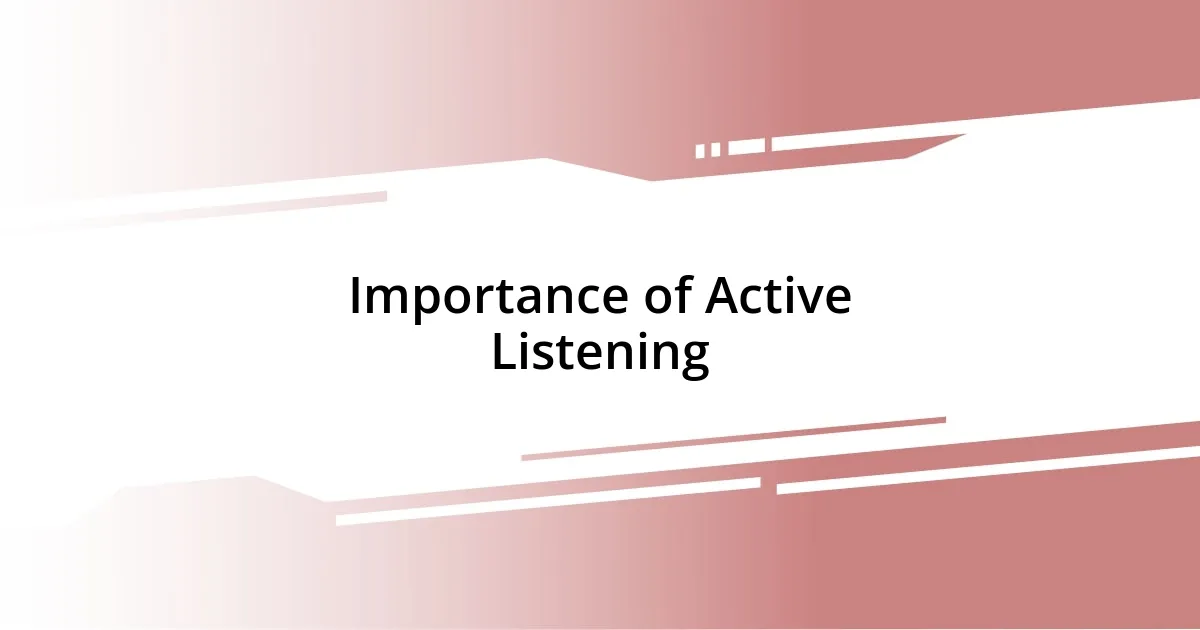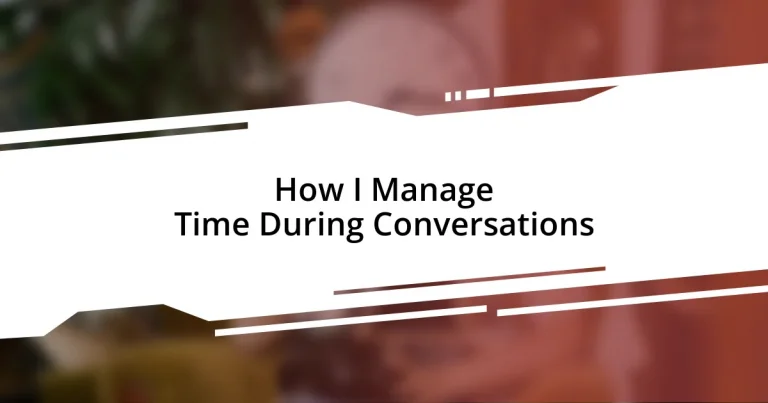Key takeaways:
- Effective time management in conversations involves prioritizing engagement over detail, creating space for deeper understanding.
- Active listening enhances communication by building trust, encouraging engagement, and facilitating empathy and problem-solving.
- Setting clear conversation goals helps maintain focus and productivity, ensuring meaningful outcomes and collaboration.
- Reflecting on conversation outcomes provides insights for improvement and strengthens relationships through gratitude and ongoing dialogue.

Understanding Time Management
Time management is not just about allocating minutes and hours; it’s about prioritizing what truly matters in our conversations. I remember a time when I was in a meeting and kept losing track of the discussion because I was overly focused on jotting down every detail instead of engaging fully. Have you ever felt that urgency to capture everything, only to miss the essence of what’s being shared?
I often reflect on how my emotional state influences my time management during conversations. When I’m feeling anxious, I tend to rush through interactions, eager to get to the end. This rush can lead to misunderstandings or missed opportunities to connect on a deeper level. Have you noticed how a more relaxed demeanor can create space for richer dialogue?
In my experience, incorporating structured pauses has dramatically improved how I manage time during discussions. By intentionally allowing for brief moments of silence, I find that it gives both me and the other person a chance to process thoughts more deeply. How might your conversations change if you embraced the power of pauses? These small adjustments can transform our interactions into meaningful exchanges.

Importance of Active Listening
Active listening is truly at the heart of effective communication. I’ve experienced moments when simply tuning in transformed the flow of a conversation. Once, I was in a discussion where the other person clearly felt unheard, which led to frustration on both sides. But when I began to focus on their words, nodding and summarizing what they said, the atmosphere shifted dramatically. Suddenly, they felt validated, and the conversation naturally flowed with more depth and connection. It’s fascinating how just being present can foster that rich exchange of ideas.
Here are a few reasons why active listening is so vital:
- Enhances Understanding: It helps clarify meanings and intentions, reducing the chances of miscommunication.
- Builds Trust: When others feel heard, they are more likely to be open and vulnerable.
- Encourages Engagement: It invites deeper participation, making the conversation more dynamic.
- Promotes Empathy: By genuinely listening, we grasp the emotional undertones in a dialogue, facilitating stronger connections.
- Facilitates Problem-Solving: When both parties feel understood, they can collaboratively work towards effective solutions.
Embracing active listening not only saves time during conversations but enriches them in unexpected ways. There’s something profoundly rewarding about making someone feel truly valued in their expression.

Setting Clear Conversation Goals
Setting clear goals for conversations is a game changer. I remember entering a discussion without a clear purpose and feeling like I was going in circles. It often felt like a waste of time. But when I started defining what I wanted to achieve—be it resolving a conflict or brainstorming ideas—everything fell into place. Having a specific goal makes it easier for both parties to stay on track and ensures that we actually accomplish something meaningful.
I’ve also noticed that sharing my conversation goals at the start creates a sense of partnership. For instance, during a recent collaboration, I outlined my objective to gather feedback on a project. This simple step encouraged my colleagues to share their thoughts more freely, as they understood how their input would fit into the bigger picture. Have you ever thought about how sharing your intentions could transform your discussions?
Even if our goals shift during the conversation, setting clear objectives initially helps us gauge progress. It’s like having a reference point in a map; we can always navigate back if we get sidetracked. I’ve found that by sometimes referring back to our goals, we can realign when the conversation veers off track, leading to a more productive and fulfilling exchange.
| Goal Setting | Benefits |
|---|---|
| Define Clear Objectives | Provides direction and focus |
| Share Goals with Others | Encourages collaborative dialogue |
| Adapt as Needed | Maintains productivity, even with changes |

Techniques for Effective Time Usage
One technique I find incredibly useful for effective time usage in conversations is to use a timer. When I started doing this, I was astounded by how it transformed my discussions. For example, I set a timer for 15 minutes during a planning meeting, and it surprisingly made everyone more focused. We all knew we had a limited time, which encouraged us to get to the point and avoid unnecessary digressions. Have you ever noticed how the ticking clock can create just the right kind of urgency?
Another approach I swear by is summarizing key points throughout the conversation. I often make a conscious effort to pause and reflect back what I’ve heard. This not only shows the other person that I’m actively engaged, but it also provides clarity. Just last week, during a brainstorming session, I summarized the ideas shared every few minutes. This helped us pivot quickly to our next topic, ensuring we made the best use of our time. Isn’t it satisfying to leave a conversation feeling, “Wow, we really covered a lot today?”
Lastly, I’ve learned the importance of pausing for feedback. Perhaps you’ve been in a situation where you feel like you’re talking over someone. I used to be that person, eager to share my thoughts but missing the chance to invite others in. Now, I pause and ask open-ended questions like, “What are your thoughts on this?” This simple act opens up the floor for a richer dialogue and often reveals insights I hadn’t considered. Effective time management isn’t just about talking less; it’s about inviting more voices into the conversation.

Balancing Speaking and Listening
Striking the right balance between speaking and listening can truly enhance the quality of any conversation. I recall a time when I dominated a discussion, pouring out my ideas without giving space for others to voice theirs. The tension in the room was palpable, and I could almost feel the energy draining away. Since then, I’ve made a conscious effort to listen actively. It’s amazing how much richer our discussions become when I genuinely tune in to others, not just waiting for my turn to speak.
Being mindful of how much time I spend talking versus listening has shifted my approach significantly. I often ask myself, “Am I contributing to the dialogue or just filling the space with my voice?” For instance, during a team project, I made it a habit to pause every few minutes and invite opinions from others. Not only did this allow for a variety of perspectives, but it also fostered a collaborative spirit that energized the whole group. Have you experienced the power of simply asking others for their insights?
I’ve also learned the importance of non-verbal signals in balancing these two elements. I remember noticing that when I leaned in and maintained eye contact, it encouraged my conversation partner to share more openly. Conversely, there were moments when I noticed people disengaging when I rabbit-holed into my own thoughts. By being aware of these cues, I’ve become more adept at adjusting my speaking time based on the feedback I receive, ultimately creating a space where everyone feels valued and engaged. How often do you consider your body language during conversations? It can make all the difference.

Managing Interruptions and Distractions
Managing interruptions and distractions in conversations can be challenging, but I’ve found a few strategies that help me maintain focus. For instance, during a heated discussion last week, my phone buzzed with notifications. Rather than letting it derail the conversation, I politely set my phone face down on the table, signaling to my conversation partner that I was fully present. Have you ever noticed how just a simple action can communicate your commitment?
Another technique I utilize is creating a distraction-free environment whenever possible. When I know I’ll be having an important talk—like a performance review or a brainstorming session—I opt for quieter spaces to minimize outside noise. I remember one particular meeting where we chose a cozy café away from the office. The peaceful ambiance allowed us to connect deeply without the usual office interruptions. It made me think, how often do we overlook our surroundings when seeking meaningful conversations?
Lastly, I’ve learned to embrace the art of redirecting. Sometimes, people get off track due to distractions or thoughts that pop up mid-conversation. For example, if someone starts veering off topic, I gently interject with a question that steers us back to the core subject. Just last month in a strategy meeting, I asked, “How does this point align with our main goal?” It wasn’t just about keeping the conversation on course; it reinforced our collective focus. Isn’t it fascinating how a simple question can refocus energy and drive?

Reflecting on Conversation Outcomes
Reflecting on the outcomes of a conversation is something I’ve come to cherish. After a meaningful talk, I often take a moment to assess what went well and what could have been improved. I remember once wrapping up a dialogue with a friend and feeling a mix of satisfaction and curiosity. Did I truly convey my thoughts? Did they feel heard? This reflection helps me grow and prepare better for future interactions.
Moreover, I’ve learned that the aftermath of any conversation can provide valuable insights into our communication styles. I recall a time when a colleague pointed out that I sometimes overshadow their input. Initially, I felt defensive, but then I realized they were offering feedback to help me enhance our exchanges. Incorporating their perspective, I started to jot down notes on key points during discussions, ensuring I revisit what others have shared. This simple adjustment has made my conversations feel more collaborative. Have you ever paused to think about how feedback can transform your interactions?
Finally, I often find that reflecting on my conversation outcomes allows me to connect more deeply with others. After a particularly inspiring discussion with a mentor, I took time to meditate on what moved me. It struck me that their passion for the topic wasn’t just inspiring; it ignited my own enthusiasm. I now make it a practice to reach out afterward to express gratitude for impactful chats. This not only reinforces our bond but also encourages an ongoing dialogue. Isn’t it remarkable how a little reflection can deepen relationships?














